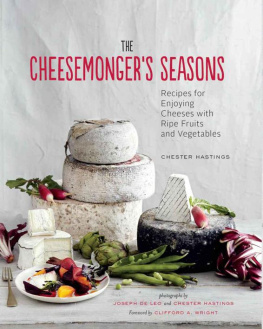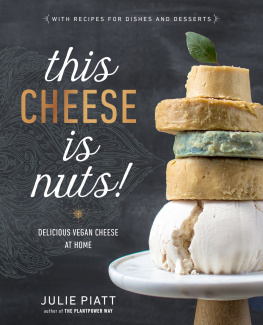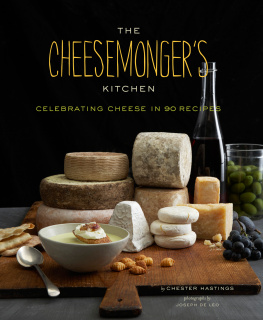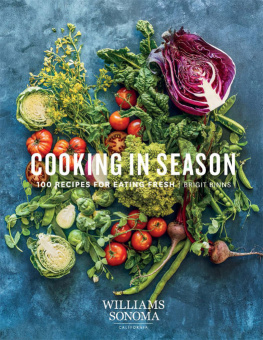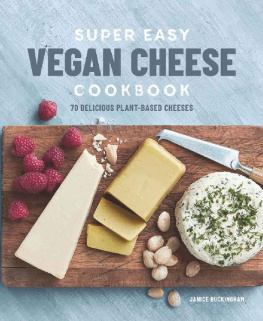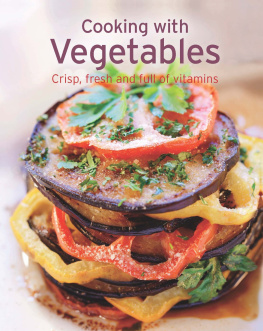



Text copyright 2014 by Chester Hastings. Photographs copyright 2014 by Joseph De Leo.
All rights reserved. No part of this book may be reproduced in any form without written permission from the publisher.
Library of Congress Cataloging-in-Publication Data available.
ISBN 978-1-4521-1288-6 (hc) ISBN 978-1-4521-3554-0 (epub, mobi)
Design by VANESSA DINA Food styling by CHRISTINE ALBANO Prop styling by LUCY ATTWATER
Joseph De Leo wishes to thank his crew, Kaz, Christine,Lucy, and Nora, for their incredible talents and enthusiasm.
Thank you also to Chester Hastings and Vanessa Dina for allowing me to work on another beautiful project, and to ABC Carpet and Home, Murrays Cheeses, and Melissas Produce for your contributions.
Photographs on pages by Chester Hastings.
Excerpt on from The Snack Thief by Andrea Camilleri, translated by Stephen Sartarelli, and published in 2004 by Penguin Group (USA).
Chronicle Books LLC 680 Second Street San Francisco, California 94107 www.chroniclebooks.com

FOR SUSIE, HENRY, AND MOLLY
Behind every cheese there is a pasture of a different green under a different sky.
ITALO CALVINO
ACKNOWLEDGMENTS
I would like to thank my loving and beautiful wife, Susie, for her never-ending faith in me. She makes so many dreams a reality.
I am very grateful to the prolific and generous Clifford Wright, whose brilliant works have inspired me beyond measure. I would also like to thank Joan McNamara, for her continued passion and support; Dean McCreary, for his valued insanity and perseverance; and Brian Kalliel, for his friendship and wisdom.
This book is also written with profound gratitude for my mentor and friend, Carlo Middione.


FOREWORD
BY CLIFFORD A. WRIGHT
When I first met Chester Hastings twenty years ago, he was an apprentice to Master Chef Carlo Middione, who gave a dinner celebrating my first cookbook. Little did I realize that this young man not only would come to write cookbooks but that he would do so with a panache and suaveness that would open up a world of foods and seduce his readers into the kitchen. There is no greater joy than to have ones eyes opened to a subject that one believes one knows well. This is the effect The Cheesemongers Seasons has had on me.
Cheese has come a long way in this country from the daysdays that I remember in the late 1960swhen rubbery mozzarella, canned Parmesan, and cheese by-products such as Velveeta were the only offerings. Back then, there were no cheese stores, no artisanal cheeseor artisanal anything for that matter. Today, a wide world of cheese has arrived in our kitchens. Not only do we need a guide to introduce us to unfamiliar cheeses, we need The Cheesemongers Seasons to teach us to cook with the array of cheeses that we can now readily find.
In his own summa lacticiniorum, Chester has continued a great tradition that began with the first treatise ever written on cheese, the Summa lacticiniorum by Pantaleone da Confienza, a professor at the University of Turin who published his veritable encyclopedia in 1459. Pantaleones book is devoted to environmental, hygienic, dietetic, economic, and gastronomic aspects concerning the production of milk, and, above all, cheeses, whose extensive varieties are listed for the first time.
Echoing La Formaggiata published in 1542 by Guido Landi in honor of cacio piacentino, better known as Parmesan cheese, Chester says it all begins with grass. How else to understand the seasons of cheese, this marvelous food resulting from the magical transformation of milk? After grass comes milk, and after milk comes cheese; and in this book, those fabulous cheesesnow far more readily available than yesteryearare utilized in some of the most intriguing and enticing of recipes. Take for instance Coffee-Rubbed Leg of Lamb Stuffed with Spinach and Aged Cheddar, a dish about which Chester says, I had been meaning to try cooking lamb with coffee for years. I read this recipe and nearly dropped everything to give it a try. And this was only one recipe. Every recipe in this book is like a persuasive carnival barker drawing you in unrelentingly.
When Chester writes about summers arrival in the French Alps, when animals are moved to graze on higher pastures, where grasses they feed on are peppered with wildflowers that impart flavors to rich milk, you can almost taste it. Then you see, as you peruse this book, recipes that leap out and you can almost taste them they are so inviting. I write this in the spring, so Im drawn to that section, as the book is divided by seasons, and I read about Little Gem Lettuces with Rogue River Blue, Agen Prunes, and Walnut Oil Vinaigrette; Spaetzle with Fried Onions and Beaufort dAlpage; and Frittata with Dandelion Greens and Ossau Iraty. I am open-eyed and open-mouthed as I know Im in the competent hands of a master cheesemonger and master cook.
Writing this foreword was difficult for me because this was one of those rare cookbooks that drew me away from my computer and pushed me toward my kitchen, such was the allure of these recipes. There is no better guide into the world of cheeses than Chester Hastings and The Cheesemongers Seasons.
INTRODUCTION
In my first cookbook, The Cheesemongers Kitchen,I stated that of all the chapters for cooking with cheese, Vegetables was the hardest chapter to whittle down. The possibilities for marrying top-quality produce with the worlds finest cheeses are endless. The best recipes are often the simplest, as truly great cheese and ripe, in-season fruits and vegetables all share the character of being best appreciated as purely as can be. More important, cheese, like fresh fruits and many vegetables, should be cooked as little as possible. This kind of cooking epitomizes the key to re-creating the great cuisines of Western Europe: take very good ingredients and do very little to them.
The proliferation of farmers markets and the availability of high-quality organic, seasonal, and local foods in grocery stores across the map are slowly improving the landscape of American and British diets. More and more top restaurants and local eateries are focusing on a Mediterranean approach to cooking: creatively using the best produce from reliable sources, always seeking to highlight the complex and glorious flavors of the garden.
The Dairy and the Garden
The heart of cheesemaking has always been the farm. Cheese is as much an agricultural product as it is an artisanal one. The humble and wholesome cooking of rural France, Italy, and Spain, as well as the farmstead kitchens of the United Kingdom and the United States, are replete with the traditional union of the pasture and the field.
Next page
